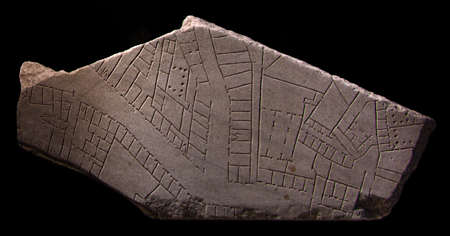Stanford Digital Forma Urbis Romae Project Home (original) (raw)
Stanford Digital Forma Urbis Romae Project
| Home | Project | Map | Database | Slab Map | Glossary | Bibliography | People | Links | | | ------------------ | ------------------------------- | ----------------------- | --------------------------- | -------------------------------- | --------------------------------- | ----------------------------------- | ----------------------------- | --------------------------- | |
 Fragment [10g](./fragment.php?record=1&field0=stanford &search0=10g&op0=and&field1=all) shows part of the Subura, a notorious neighborhood of imperial Rome.It includes a major street, the Clivus Suburanus, as well as alleys, streetfront shops,apartment buildings, courtyards, possible commercial and industrial spaces, aneighborhood bathing establishment and a possible brothel. Fragment [10g](./fragment.php?record=1&field0=stanford &search0=10g&op0=and&field1=all) shows part of the Subura, a notorious neighborhood of imperial Rome.It includes a major street, the Clivus Suburanus, as well as alleys, streetfront shops,apartment buildings, courtyards, possible commercial and industrial spaces, aneighborhood bathing establishment and a possible brothel. |
What's New: All 1,186 surviving fragments are now online!Two new papers, one describing the entire project and the other describing new fragment matches we found.Lost fragmentsknown only from 16th- and 17th-century drawingsPreliminary digital slab map of the wall |
|---|
Welcome
This site is dedicated to exploring the Forma Urbis Romae, or Severan Marble Plan of Rome. This enormous map, measuring ca. 18.10 x 13 meters (ca. 60 x 43 feet), was carved between 203-211 CE and covered an entire wall inside the Templum Pacis in Rome. It depicted the groundplan of every architectural feature in the ancient city, from large public monuments to small shops, rooms, and even staircases. For more information about the map itself, go to the Map page.
The Severan Marble Plan is a key resource for the study of ancient Rome, but only 10-15% of the map survives, broken into 1,186 pieces. For centuries, scholars have tried to match the fragments and reconstruct this great puzzle, but progress is slow--the marble pieces are heavy, unwieldy, and not easily accessible. Now, computer scientists and archaeologists at Stanford are employing digital technologies to try to reconstruct the map. In collaboration with the Sovraintendenza of the Comune di Roma, a team from Stanford's Computer Graphics laboratory has been creating digital photographs and 3D models of all 1,186 fragments. The next step is to develop 3D matching algorithms to "solve the map," and to build a fully searchable database of the fragments--a much-needed tool for archaeological research. To read about our aims and methods in detail, go to the Project page. To know who is involved, click on People.
This site presents 1,186 of the surviving fragments and 87 fragments known only from Renaissance drawings in a fully searchable database. Each entry includes digital color photographs and 3D models (download our viewer, for Windows PCs only), a search box, a description of the fragment, an analysis of its significance and a review of the scholarly literature.
Our aim is to make this material accessible to specialists, students and the general public. The project is a joint effort between computer scientists from the Department of Computer Science, archaeologists from the Department of Classics at Stanford, and the Sovraintendenza of the City of Rome. We are still developing this site; please contact us with your comments through the People page.
The text and images contained in these web pages are protected by copyright law. Please refer to the copyright notice for more information.
This project has been sponsored by the National Science Foundationunder the name Solving the Puzzle of the Forma Urbis Romae. Some of the early work was funded under an NSF Digital Libraries Initiativepilot grant called Creating Digital Archives of 3D Artworks. Additional funding has been provided by Stanford University's President's Fund, Program on Urban Studies, and UPS Endowment Fund, Interval Research Corporation, The Paul G. Allen Foundation for the Arts, The Mellon Foundation, The City of Rome, and Pierluigi Zappacosta.
Copyright © 2002-2016 The Stanford Digital Forma Urbis Romae Project